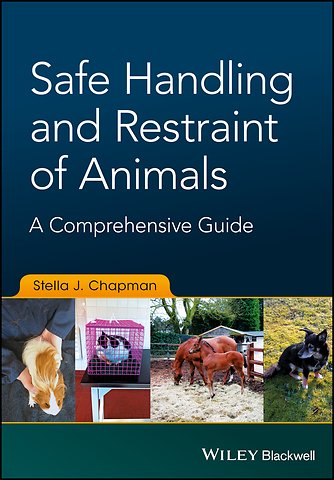Safe Handling and Restraint of Animals – a Comprehensive Guide
A Comprehensive Guide
Samenvatting
Provides all you need to know about the safe and humane handling and restraint of animals.
Safe Handling and Restraint of Animals takes a holistic approach to the handling of a wide variety of animal species. This comprehensive resource offers a thorough overview of how to safely handle and restrain a number of commonly encountered species including dogs, cats, small mammals, exotic pets, horses and farm animals. Each chapter discusses the behaviour of the species and then outlines the appropriate handling and restraint methods, including any equipment required, multiple explanatory photographs, and useful further reading.
Covers a wide range of species commonly encountered by veterinary staff and those working within animal industries
Includes key points and self–assessment questions at the end of each chapter, and a glossary of terms
Ideal for students of any animal–related degree or diploma programme, including veterinary medicine, veterinary nursing, and animal studies and husbandry
Written for students and professionals who work with animals, Safe Handling and Restraint of Animals: A Comprehensive Guide encompasses all aspects of handling and physical restraint, including biosecurity and welfare issues.
Specificaties
Inhoudsopgave
<p>Acknowledgement</p>
<p>Chapter One: Biosecurity and Personal Equipment for Safe Handling and Restraint of Animals</p>
<p>1.1 Transmission of disease</p>
<p>1.2 Infection control</p>
<p>1.3 Assessing the risk</p>
<p>1.4 Personal hygiene</p>
<p>1.5 Personal protective equipment</p>
<p>1.6 Key points</p>
<p>1.7 Self–assessment questions</p>
<p>1.8 References</p>
<p>1.9 Further reading</p>
<p>Chapter Two: Welfare Considerations for the Safe Handling and Restraint of Animals</p>
<p>2.1 The human–animal bond: domestication as a consideration of welfare</p>
<p>2.2 Welfare considerations</p>
<p>2.3 Types of restraints and consideration for animal welfare</p>
<p>2.4 Stress and implications for handling and restraint</p>
<p>2.5 Key points</p>
<p>2.6 Self–assessment questions</p>
<p>2.7 References</p>
<p>2.8 Further reading</p>
<p>Chapter Three: Handling and Restraint of Dogs</p>
<p>3.1 Canine behaviour</p>
<p>3.2 Handling and restraint of dogs</p>
<p>3.3 Ancillary equipment</p>
<p>3.4 Training for restraint</p>
<p>3.5 Special considerations</p>
<p>3.6 Key points</p>
<p>3.7 Self–assessment questions</p>
<p>3.8 References</p>
<p>3.9 Further reading</p>
<p>Chapter Four: Handling and Restraint of Cats</p>
<p>4.1 Feline behaviour</p>
<p>4.2 Handling and restraint of cats</p>
<p>4.3 Physical restraint</p>
<p>4.4 Ancillary equipment</p>
<p>4.5 Training for restraint</p>
<p>4.6 Special considerations</p>
<p>4.7 Key points</p>
<p>4.8 Self–assessment questions</p>
<p>4.9 References</p>
<p>4.10 Further reading</p>
<p>Chapter Five: Handling and Restraint of Rabbits</p>
<p>5.1 Behaviour of rabbits</p>
<p>5.2 Handling and restraint of rabbits</p>
<p>5.2 Aggression</p>
<p>5.4 Key points</p>
<p>5.5 Self–assessment questions</p>
<p>5.6 References</p>
<p>5.7 Further reading</p>
<p>Chapter Six: Handling and Restraint of Rodents</p>
<p>6.1 General species information</p>
<p>6.2 Behaviour of rodents</p>
<p>6.3 Handling and restraint of small rodents</p>
<p>6.4 Handling and restraint of rats</p>
<p>6.5 Handling and restraint of guinea pigs</p>
<p>6.6 Key points</p>
<p>6.7 Self–assessment questions</p>
<p>6.8 References</p>
<p>6.9 Further reading</p>
<p>Chapter Seven: Handling and Restraint of Ferrets</p>
<p>7.1 Behaviour of ferrets</p>
<p>7.2 Handling and restraint of ferrets</p>
<p>7.3 Key points</p>
<p>7.4 Self–assessment questions</p>
<p>7.5 References</p>
<p>7.6 Further reading</p>
<p>Chapter Eight: Handling and Restraint of Horses and Donkeys</p>
<p>8.1 Equine behaviour</p>
<p>8.2 How to approach a horse/donkey</p>
<p>8.3 How to put on a headcollar and lead in hand</p>
<p>8.4 Physical restraint</p>
<p>8.5 Training for restraint</p>
<p>8.6 Handling and restraint of foals</p>
<p>8.7 Handling and restraint of stallions</p>
<p>8.8 Key points</p>
<p>8.9 Self–assessment questions</p>
<p>8.10 References</p>
<p>8.11 Further reading</p>
<p>Chapter Nine: Handling and Restraint of Cattle</p>
<p>9.1 Behaviour of cattle</p>
<p>9.2 How to use behavioural traits to good effect when handling</p>
<p>9.3 How to approach and move cattle</p>
<p>9.4 Handling facilities</p>
<p>9.5 How to restrain cattle</p>
<p>9.6 Training for restraint</p>
<p>9.7 Special considerations</p>
<p>9.8 Key points</p>
<p>9.9 Self–assessment questions</p>
<p>9.10 References</p>
<p>9.11 Further reading</p>
<p>Chapter Ten: Handling and Restraint of Small Ruminants</p>
<p>10.1 Behaviour</p>
<p>10.2 How to approach and move sheep</p>
<p>10.3 How to approach and move goats</p>
<p>10.4 How to restrain sheep</p>
<p>10.5 How to restrain goats</p>
<p>10.6 Special Considerations</p>
<p>10.7 Key points</p>
<p>10.8 Self–assessment questions</p>
<p>10.9 References</p>
<p>10.10 Further Reading</p>
<p>Chapter Eleven: Handling and Restraint of Pigs</p>
<p>11.1 Behaviour</p>
<p>11.2 How to approach and move pigs</p>
<p>11.3 How to restrain pigs</p>
<p>11.4 Special considerations</p>
<p>11.5 Key points</p>
<p>11.6 Self–assessment questions</p>
<p>11.7 References</p>
<p>11.7 Further reading</p>
<p>Chapter Twelve: Handling and Restraint of South American Camelids</p>
<p>12.1 Behaviour</p>
<p>12.2 How to use behavioural traits to effect when handling</p>
<p>12.3 How to approach and halter a camelid</p>
<p>12.4 How to restrain a camelid</p>
<p>12.5 Training cria</p>
<p>12.6 Special considerations</p>
<p>12.7 Key points</p>
<p>12.8 Self–assessment questions</p>
<p>12.9 References</p>
<p>12.10 Further reading</p>
<p>Chapter Thirteen: Handling and Restraint of Poultry and Aviary Birds</p>
<p>13.1 Behavioural considerations</p>
<p>13.2 Anatomical considerations</p>
<p>13.3 How to restrain birds</p>
<p>13.4 Handling techniques for common cage and aviary species</p>
<p>13.5 Key points</p>
<p>13.6 Self–assessment questions</p>
<p>13.7 References</p>
<p>13.8 Further reading</p>
<p>Chapter Fourteen: Handling and Restraint of Reptiles</p>
<p>14.1 Behaviour and special considerations</p>
<p>14.2 Restraint and handling of snakes</p>
<p>14.3 Restraint and handling of lizards</p>
<p>14.4 Restraint and handling of chelonians</p>
<p>14.5 Key points</p>
<p>14.6 Self–assessment questions</p>
<p>14.7 References</p>
<p>14.8 Further reading</p>
<p>Glossary</p>
<p>Answers to Questions</p>
<p>Index</p>
Net verschenen
Rubrieken
- aanbestedingsrecht
- aansprakelijkheids- en verzekeringsrecht
- accountancy
- algemeen juridisch
- arbeidsrecht
- bank- en effectenrecht
- bestuursrecht
- bouwrecht
- burgerlijk recht en procesrecht
- europees-internationaal recht
- fiscaal recht
- gezondheidsrecht
- insolventierecht
- intellectuele eigendom en ict-recht
- management
- mens en maatschappij
- milieu- en omgevingsrecht
- notarieel recht
- ondernemingsrecht
- pensioenrecht
- personen- en familierecht
- sociale zekerheidsrecht
- staatsrecht
- strafrecht en criminologie
- vastgoed- en huurrecht
- vreemdelingenrecht

